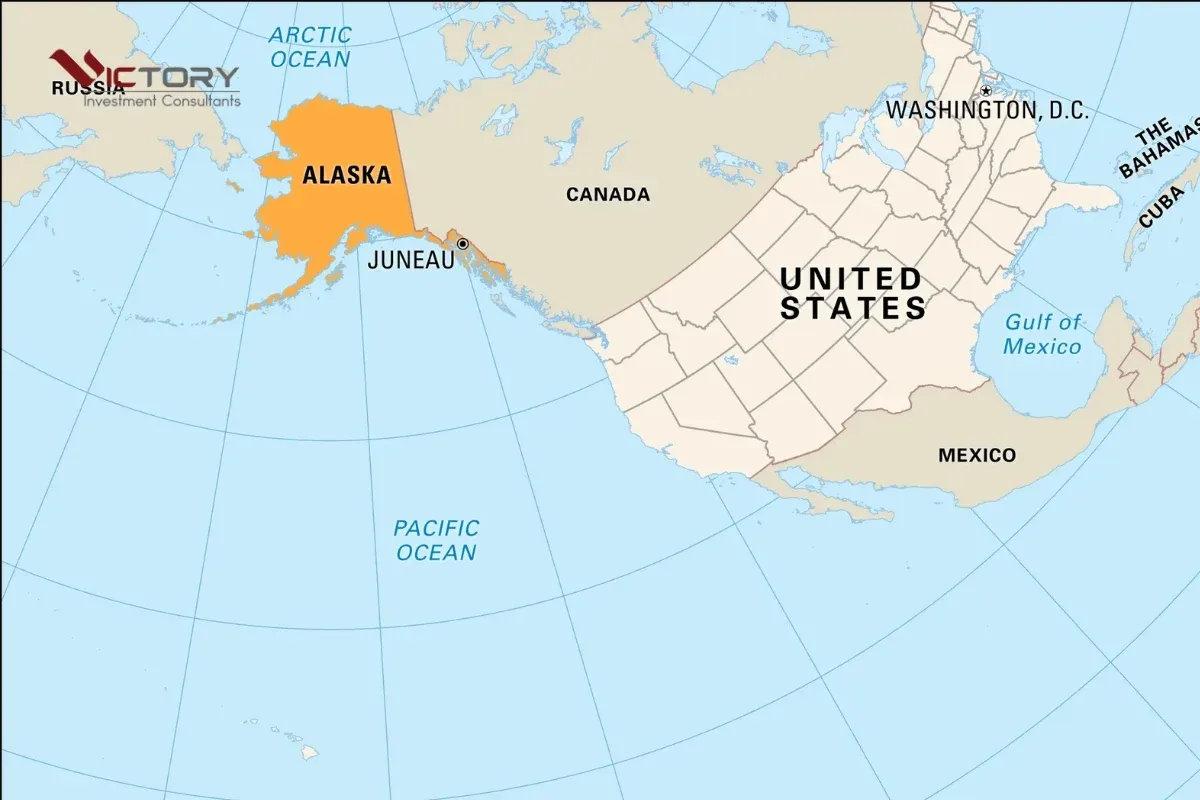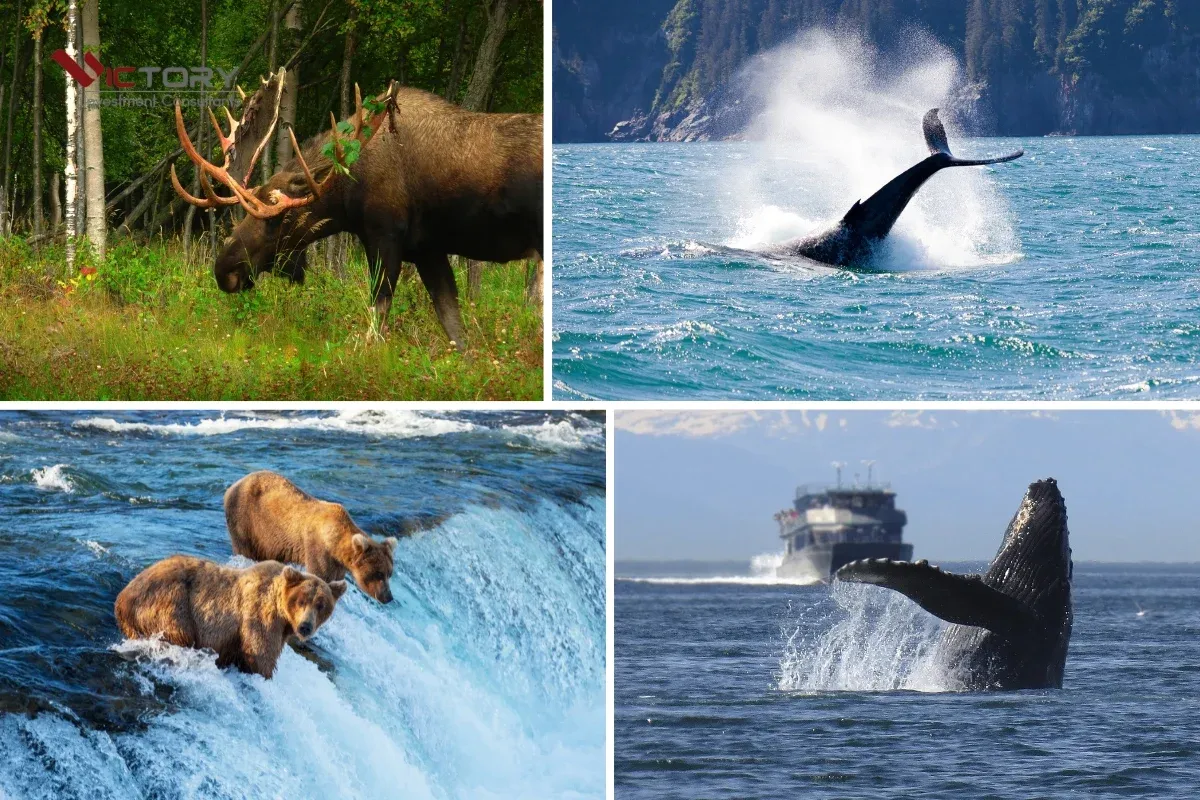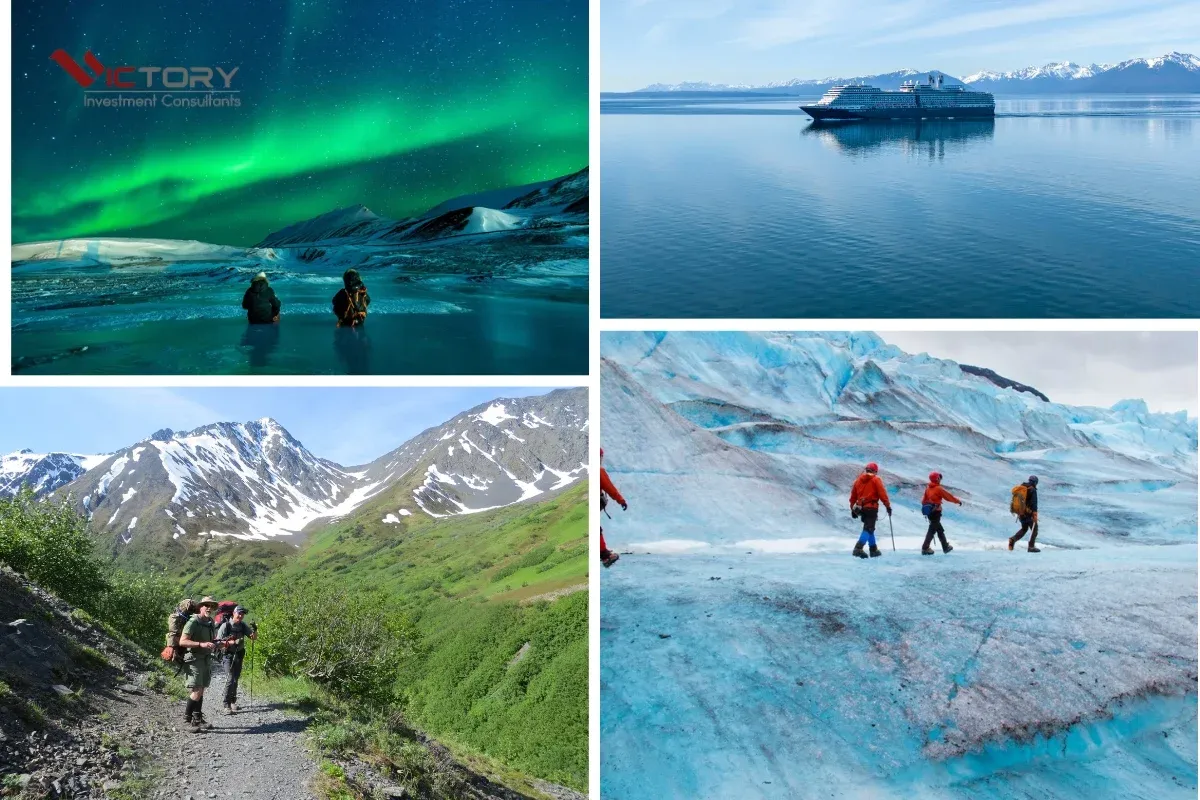Alaska, the land of majestic mountains and untouched wilderness, is not only a dream destination for adventure travelers but also a paradise for hunting enthusiasts. With its vast forests and diverse wildlife, Alaska offers unique and challenging hunting opportunities. However, to fully experience hunting here legally and responsibly, understanding the regulations and best practices is crucial. This guide from “Du lịch khắp thế gian” (Travel the World) provides detailed insights into legal hunting in Alaska’s forests, helping you prepare for your wilderness adventure.
Introduction to Legal Hunting in Alaska
Hunting is more than just a recreational activity; it’s a deeply rooted part of Alaska’s culture and history. Indigenous communities have relied on hunting for survival for centuries, and today, it remains vital to the state’s economy and social fabric. Alaska is renowned for its diverse wildlife, from massive moose and powerful brown bears to graceful caribou and various birds and small game. This biodiversity draws hunting enthusiasts from around the globe.
However, Alaska is also committed to nature conservation and maintaining ecological balance. Therefore, hunting in Alaska is strictly regulated by stringent laws. The goal is to ensure sustainable hunting practices that do not negatively impact wildlife populations and the natural environment. Adhering to these laws is not just an obligation but a responsibility for every hunter to help protect this precious resource for future generations. This article will delve into the legal aspects and practical experiences to help you fully enjoy your passion for hunting in Alaska legally and responsibly.

Alaska Hunting Laws and Regulations
To hunt legally in Alaska, you must be familiar with current regulations and laws. The primary managing agency for hunting in Alaska is the Alaska Department of Fish and Game (ADF&G). ADF&G is responsible for creating and enforcing regulations, issuing permits, and managing hunting activities throughout the state. Thoroughly understanding and complying with these regulations is the first and most crucial step for a successful and lawful hunting trip.
Licenses and Hunting Tags
Anyone wishing to hunt in Alaska, except for Alaska Natives who are exempt under federal law, must possess a valid hunting license. Hunting licenses can be purchased online on the ADF&G website or at authorized vendors throughout the state. In addition to a general hunting license, you may need specific tags or permits depending on the animal you intend to hunt and the hunting area. For example, hunting big game animals like bears, moose, and caribou typically requires separate hunting tags for each species. These tags are often limited in number and may be issued through a lottery system or purchased directly, depending on the area and animal.
Hunting Seasons and Areas
Each animal species and hunting area in Alaska has distinct hunting seasons, specifically set annually by ADF&G. Hunting seasons are established based on biological factors such as breeding cycles, migration patterns, and population numbers of each species, ensuring sustainable hunting practices. Hunting outside of the designated season or in prohibited areas is a serious legal violation.
Alaska is divided into various Game Management Units (GMUs), each with specific regulations regarding hunting seasons, permissible species, quotas, and hunting methods. Some areas may be completely closed to hunting or restrict who can hunt there (e.g., residents of Alaska only). You must clearly identify your intended hunting area and thoroughly research the regulations applicable to that area before your trip.
Hunting Methods and Weapons
Alaska law specifies the types of weapons and methods permitted for hunting different animal species. For big game, rifles, handguns, or bows with sufficient stopping power are generally allowed. Firearms must comply with caliber and ammunition regulations. The use of automatic or semi-automatic weapons may be restricted in some cases.
Transportation methods during hunting are also regulated. The use of motorized vehicles (such as ATVs, snowmobiles) may be prohibited or restricted in certain areas to protect the environment and minimize disturbance to wildlife.
Ethical Hunting and Conservation Regulations
Beyond legal regulations, hunting ethics are also essential. Ethical hunting requires hunters to respect nature, wildlife, and the rights of others. This includes only shooting an animal when you are certain you can retrieve it, avoiding unnecessary suffering, not littering in nature, and adhering to the principle of “Fair Chase,” meaning not using unfair methods or techniques to gain an advantage over the animal.
Alaska also has conservation regulations, requiring hunters to collect and submit specimens (such as teeth, hair, blood samples) from certain animal species for research and population management purposes. Cooperating with management agencies and participating in conservation efforts is part of a hunter’s responsibility.
Popular Forest Hunting Areas in Alaska
Alaska boasts numerous vast and diverse forest areas, each offering unique hunting experiences. Here are some popular forest areas favored by many hunters:
Tongass National Forest
Tongass National Forest is the largest national forest in the United States, located in Southeast Alaska. Covering nearly 68,000 square kilometers, Tongass includes coastal temperate rainforest, rugged mountains, glaciers, and fjords. It’s an ideal habitat for many wildlife species, including black bears, brown bears, Sitka black-tailed deer, mountain goats, and various birds. Sitka black-tailed deer and black bear hunting are popular activities in Tongass. The area has complex terrain, wet weather, and many remote areas, requiring hunters to be in good physical condition and possess advanced survival skills.
Chugach National Forest
Chugach National Forest is located in South-Central Alaska, surrounding the city of Anchorage. Chugach is the second-largest national forest in the U.S., covering approximately 55,000 square kilometers. Chugach’s terrain is diverse, ranging from coastal areas to high mountains, glaciers, and taiga forests. It’s home to moose, brown bears, Dall sheep, mountain goats, and caribou. Moose and brown bear hunting are primary targets for many hunters in Chugach. The area has numerous trails and campsites, facilitating access and exploration. However, Chugach weather can be unpredictable, requiring careful preparation of equipment and plans.
Interior Alaska
Interior Alaska encompasses much of central and northern Alaska, stretching from the Alaska Range to the Arctic. Forests in this region are primarily taiga and Arctic tundra, with unique and diverse ecosystems. Interior Alaska is home to caribou, moose, grizzly bears, wolves, and foxes. Caribou and moose hunting are common activities in the Interior. The area has a harsh continental climate, with cold winters and short summers. Hunting in Interior Alaska often requires using aircraft or boats to reach remote areas and necessitates wilderness survival experience in extreme weather conditions.
Kenai Peninsula
The Kenai Peninsula, south of Anchorage, is another popular hunting destination in Alaska. Kenai features a mix of forests, mountains, rivers, and lakes, creating diverse habitats for wildlife. Moose, black bears, brown bears, mountain goats, and Dall sheep are all found in Kenai. Moose and bear hunting attract many visitors to Kenai. The Kenai Peninsula has more developed infrastructure than other areas, with towns, roads, and tourist services. However, due to its popularity, hunting pressure in Kenai is higher, requiring strict adherence to regulations and responsible hunting practices.

Animal Species Allowed for Hunting in Alaska Forests
Alaska’s forests are home to many fascinating wildlife species, offering diverse hunting options. Here are some common animal species that are legally hunted in Alaska’s forests:
Moose
Moose are iconic large mammals of Alaska, with a large population and wide distribution throughout the state. Moose hunting is one of the most popular and favored hunting activities in Alaska. Moose typically inhabit taiga forests, near rivers, lakes, and swamps. The moose hunting season usually occurs in the fall, during their breeding season when they are easily attracted by mating calls. Moose hunting requires tracking, stalking, and accurate shooting skills, as well as the ability to process and transport a large animal.
Bears
Alaska is home to both black bears and brown bears (including grizzly bears). Bear hunting is a significant challenge for many hunters, demanding courage, skill, and experience. Black bears are typically found in forests, while brown bears can be found in various habitats, from coastal areas to high mountains. Bear hunting seasons vary by region and species, generally occurring in spring and fall. Bear hunting requires firearms with significant stopping power and safety skills, as bears are dangerous animals.
Caribou
Caribou are migratory animals living in large herds, primarily distributed in Interior and Arctic Alaska. Caribou hunting is a vital part of the culture and economy of many Alaskan Native communities. Caribou typically inhabit tundra and open forests, migrating seasonally to find food. The caribou hunting season usually occurs in the fall when they gather in large herds for their southward migration. Caribou hunting requires herd tracking, stalking, and selecting appropriate targets.
Sitka Black-tailed Deer
Sitka black-tailed deer are smaller deer species, primarily inhabiting Southeast Alaska, especially in Tongass National Forest. Sitka black-tailed deer hunting is a popular activity in this region, particularly for local residents. Sitka black-tailed deer are adapted to the wet temperate rainforest environment and complex terrain. The deer hunting season usually occurs in the fall and early winter. Deer hunting requires stealthy movement, keen observation, and quick, accurate shots in dense forest environments.
Small Game and Birds
In addition to big game, Alaska’s forests also offer many small game and bird species for hunting, such as snowshoe hares, squirrels, otters, grouse, and ducks. Small game and bird hunting is a relaxing recreational activity, suitable for beginners or those seeking diverse hunting experiences. Small game and bird species often have longer hunting seasons and less stringent regulations than big game.

Preparing for a Hunting Trip in Alaska Forests
A successful and safe hunting trip in Alaska’s forests requires thorough preparation in all aspects, from equipment and skills to physical and mental readiness. Here are some key factors to consider when preparing for your hunting trip:
Hunting Gear and Equipment
- Firearms and Ammunition: Choose firearms suitable for the animal you intend to hunt and comply with Alaska’s firearm regulations. Ensure your firearm is in good working order and bring sufficient ammunition.
- Clothing and Footwear: Prepare warm, waterproof, and breathable clothing suitable for Alaska’s changing weather conditions. Hiking boots should be sturdy, comfortable, and have good traction.
- Navigation and Communication Devices: Carry maps, compass, GPS, or satellite navigation devices to avoid getting lost in the forest. Satellite phones or radios are essential for communication in emergencies.
- Survival Gear: Flashlight, multi-tool knife, first-aid kit, waterproof matches or lighter, emergency food, and water or water purification tools are essential survival items in the wilderness.
- Binoculars and Scopes: Binoculars help observe and spot animals from a distance. High-quality scopes enhance shooting accuracy.
- Backpacks and Gear Bags: Choose backpacks and gear bags of appropriate size, durable material, and waterproof to carry your equipment and harvested game.
Physical Fitness and Skills Training
- Good Physical Condition: Hunting in Alaska forests requires good physical fitness for long hikes, mountain climbing, carrying heavy loads, and enduring harsh weather. Prepare physically before your trip by exercising, hiking, and doing endurance-building exercises.
- Firearm Proficiency: Practice shooting regularly to improve accuracy and familiarize yourself with your firearm. Understand firearm safety and strictly adhere to safety rules.
- Navigation and Survival Skills: Learn how to use maps, compass, and GPS for navigation in the forest. Learn basic survival skills such as setting up shelter, making fire, and finding food and water in the wild.
- Hunting Skills: Research the behavior, habitats, and tracks of the animal you intend to hunt. Learn how to track, stalk animals stealthily, and choose effective shooting positions.
Planning and Mental Preparation
- Research Hunting Areas: Thoroughly research your intended hunting area, including terrain, weather, hunting regulations, and animal species present. Contact ADF&G or land management offices for the most up-to-date and accurate information.
- Detailed Planning: Plan your trip’s duration, routes, campsite locations, transportation methods, and planned activities.
- Mental Preparation: Hunting in Alaska forests is a challenging and unpredictable experience. Prepare mentally to face difficulties, be patient, and be ready to adapt to changing situations.
- Hire a Guide (if necessary): If you are new to hunting in Alaska or want to explore remote areas, hiring an experienced local guide is a good option. Guides can help you plan, provide expertise, ensure safety, and increase your chances of success.

Experiences from Hunters
To make your hunting trip in Alaska forests more complete and successful, learning from the experiences of those who have gone before is invaluable. Here are some helpful experiences and tips from seasoned Alaska hunters:
- Thoroughly Research Hunting Areas: Before going, spend time studying maps, information about terrain, weather, animal density, and specific regulations for your chosen area. Contact ADF&G or land management offices for the most current and accurate information.
- Hunt with Experienced Hunters: If you are a beginner, find a friend or hire an experienced Alaska hunting guide to accompany you. They will share knowledge, skills, and help you avoid common mistakes.
- Be Patient and Observant: Hunting is not always easy or quick. Be patient, wait, carefully observe your surroundings, and listen to the sounds of the forest. Wildlife is often very cunning and well-hidden.
- Track Animal Signs: Learn to recognize and track animal signs (such as footprints, droppings, scratches, leftover food). Signs will help you identify the species, direction of movement, and areas they frequent.
- Use Lures and Calls: In some cases, using lures or animal calls (such as mating calls, fawn distress calls) can attract animals closer. However, use them appropriately and comply with lure regulations.
- Shoot Accurately and Responsibly: When you have a shooting opportunity, ensure you can shoot accurately at a vital area to quickly and humanely take down the animal. Avoid indiscriminate shooting or shooting at unclear targets.
- Process Game Properly: After a successful hunt, quickly process your game (such as cleaning, preserving meat, hide, antlers). Learn about regulations for transporting and inspecting harvested game to ensure legal compliance.
- Respect Nature and Wildlife: Hunting is not just about harvesting meat but also an opportunity to immerse yourself in nature and experience the wild beauty of Alaska. Respect the environment, do not litter, avoid making loud noises, and do not unnecessarily disturb wildlife.
Conclusion
Legal hunting in Alaska’s forests is a unique and memorable experience for those passionate about conquering the wilderness. However, to fully and safely enjoy this journey, understanding legal regulations, thorough preparation of equipment and skills, and learning from experienced hunters are crucial. We hope this article has provided you with useful and necessary information to start planning your dream hunting trip in Alaska. Remember, hunting is not just a recreational activity but also a responsibility to conserve and respect nature. We wish you successful, safe, and meaningful hunting trips in the magnificent land of Alaska!